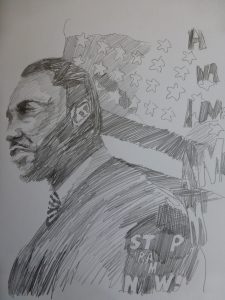Civil Rights.
From a starting point I wanted to illustrate the poem ‘I Know what the Caged Bird Feels’, by Paul Laurence Dunbar which follows:
I know what the caged bird feels, alas!
When the sun is bright on the upland slopes;
When the wind stirs soft through the springing grass,
And the river flows like a stream of glass;
When the first bird sings and the first bud opes,
And the faint perfume from its chalice steals –
I know what the caged bird feels!
I know why the caged bird beats his wing
Till its blood is red on the cruel bars;
For he must fly back to his perch and cling
When he fain would be on the bough a-swing;
And a pain still throbs in the old, old scars
And they pulse again with a keener sting –
I know why he beats his wing!
I know why the caged bird sings, ah me,
When his wing is bruised and his bosom sore, –
When he beats his bars and he would be free;
It is not a carol of joy or glee,
But a prayer that he sends from his heart’s deep core,
But a plea, that upward to Heaven he flings –
I know why the caged bird sings!
This poem has great significance during the Civil Rights movement and was the source of inspiration
for Maya Angelou autobiography ‘I Know Why the Caged Bird Sings.’
The following are a series of sketches that were attempts to outline this idea:
As this project progressed I found that the significance that I was hoping to achieve was getting lost in the renderings, I therefore shelved this idea and progressed onto a more celebratory piece of work that could be visualised as a final piece. During my research I was struck by the use of the slogan ‘I Am A Man’ and was a potent declaration of independence. This was used prolifically by campaigners of the Civil Rights movement. The question ‘Am I Not a Man?’ was brought up during a landmark trial by the US Supreme Court vs Dred Scott regarding the status of slaves in 1857. During the trial this slogan was uttered by Dred Scott. It was then reproduced during protests promoting justice, humanity and freedom. I then planned a series of illustrations around this and other slogans from the civil rights movement with depictions of protests and important figures such as Martin Luther King and Malcolm X.
Further sketches of ideas:
The challenge was to create a series on montages that once complied together convey a unified composition of themes. In this instance it was the juxtaposition between protest. The children represent the innocence of conflict, caught in the middle, whereby the black rights activists stand tall, with their hands in their pockets, as a contrast to the police that are armed with batons and gas masks. These renderings were drawn from the Voting March in Selma, Alabama of 1965.
Critical Reflection:
The final result of this project were two final pieces. Each four feet long that illustrated a celebration of black history and a commemorative acknowledgement to the protests of the time. Not confined to just the 1960’s there are further references to the current black history including the Rodney King riots of 1992 and the Black Lives Matter campaigns. The aesthetics of the two pieces are very reflective to the style of illustration that I would characterise as my own. With the freedom of space to render these images I was able to exploit my frenetic pencil style and I really enjoyed doing this. In addition to composing each section into an overall montage I carefully utilised my research into a thoughtful and considered final piece of illustrative art that I am very proud of.

















